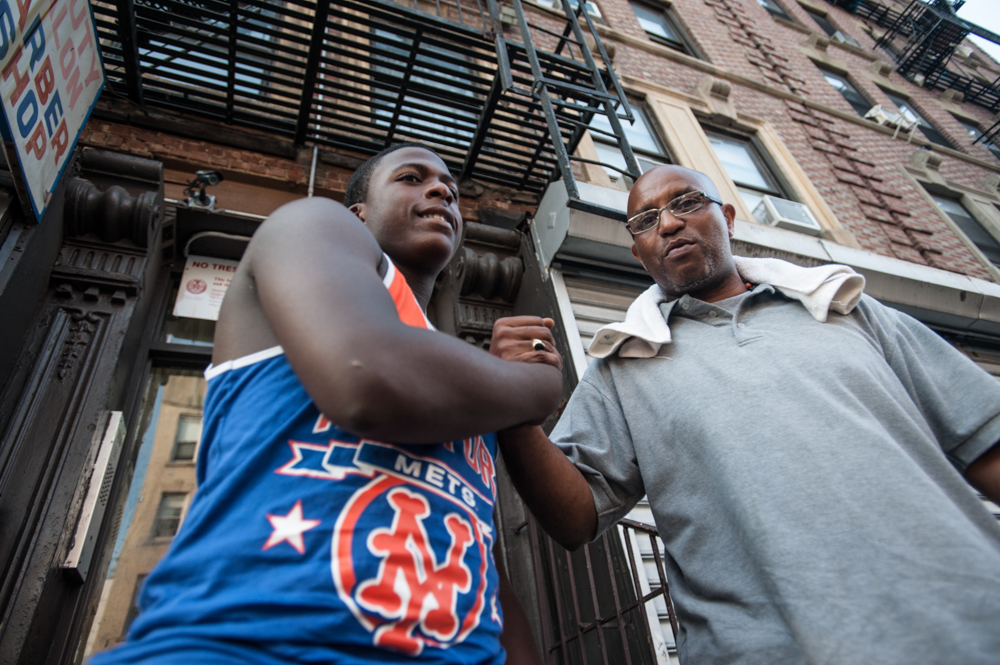“A lot of parents out here are scared of their own kids”: Venus Singleton, the mother of a boy shot as part of the blood feud between rival houses in Harlem.
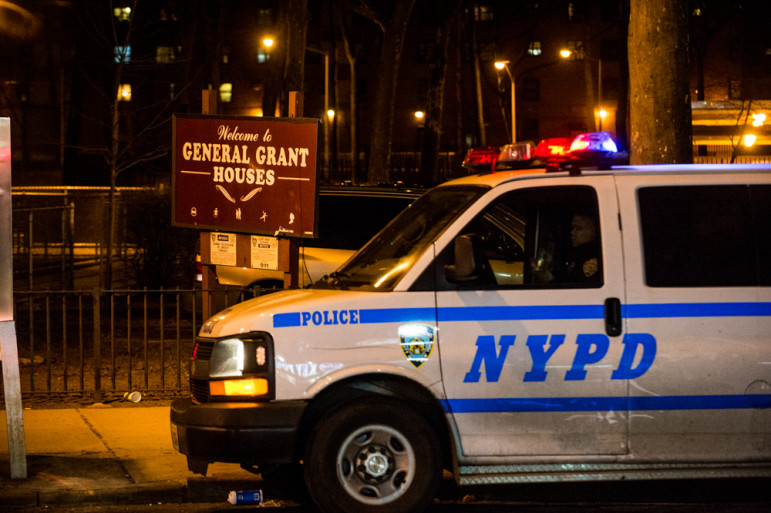
Robert Stolarik / JJIE
NEW YORK -- The killing of Tayshana Murphy on September 11, 2011 sparked a feud between the Manhattanville Houses and the Grant Houses in West Harlem, New York. A police van and security detail sit outside the Grant Houses.
From a Skirmish to a War
NEW YORK — The father of the dead girl takes a look at the brown painted door and shakes his head with contempt. He’s standing where his favorite daughter had danced moments before she was chased down and shot four flights overhead on a cool late summer morning.
 “If that door was fixed,” he says pulling at the busted entrance door, “then none of this would’ve happened. She’d be alive. Playing basketball. My life would’ve kept going like it was. But that’s not what happend. It was broken. We’re talking two years later. How can these kids be safe?”
“If that door was fixed,” he says pulling at the busted entrance door, “then none of this would’ve happened. She’d be alive. Playing basketball. My life would’ve kept going like it was. But that’s not what happend. It was broken. We’re talking two years later. How can these kids be safe?”
Taylonn Murphy ambles through the same door his daughter, Tayshana, ran through the night she was killed, and into the lobby of 3170 Broadway, one of the nine high-rise buildings that make up the General Ulysses S. Grant Houses, near the border of Harlem and Morningside Heights.
“You can’t believe the emotion that I feel walking into this building,” he said, taking a deep breath, as if to steel himself.
He walks slowly through the squalid lobby. A message is scrawled on one of the mailboxes built into the wall to the right of the elevator. It warns the police to keep out. There are two staircases in front of Murphy marked with signs indicating well A and well B.
See more photos from Harlem on JJIE's Art & Photo Blog HERE.
Murphy chooses B, the one his daughter’s killers took the morning they shot her to death on Sept. 11, 2011.
He explains the details of the case the best he knows them, after sitting in on hours of hearings and court trials. There was a fight between groups of youths from the Grant Houses and the Manhattanville Houses that night. Some youths from the Manhattanville Houses had vengeance on their mind.
“It takes a lot out of you,” he said, huffing as he climbed another of the 43 stairs, retracing the killers route one step at a time. “You try to do the best you can.”
According to the Manhattan’s district attorney’s office, Taylonn’s daughter, known to her friends, basketball teammates and family as Chicken, was outside when two young men from Manhattanville came looking to settle the score. Prosecutors described it as a “cold and calculated hit.” The two men criminally charged with shooting Murphy reportedly said they did not “give a fuck” when she pleaded with them that she was not involved in the fight.

Robert Stolarik / JJIE
Taylonn Murphy stands at the site at the Grant Houses where his daughter Tayshana Murphy was shot and killed in 2011.
Murphy, a senior at Murry Bergtraum High School for Business Careers, was considered one of the best players in the nation; a point guard. She had aspirations -- realistic ones according to scouts -- of starting for a WNBA team.
“Chicken ran up the other stairs,” her father said, trudging up the staircase. “Them boys, they came this way.”
Somewhere in the flights above, someone slammed a door sending a report echoing down the building. Murphy paused when he reached the spot where the gunman fired the shots that killed his daughter.
“He got here and at about the same time she came out of the other stairwell, and that’s when it happened,” he said. “He shot her. Pop. Pop. Pop. This is basically the spot where she died. This spot is where it went from a skirmish to a war -- to where we are today.”
 Ghostly tributes to Tayshana are barely visible on the dimly lit hallway wall. They show signs of being scrubbed off. One wishes the dead girl, a “Happy 20th BDAY.” Taylonn’s daughter was 18 when she was killed.
Ghostly tributes to Tayshana are barely visible on the dimly lit hallway wall. They show signs of being scrubbed off. One wishes the dead girl, a “Happy 20th BDAY.” Taylonn’s daughter was 18 when she was killed.
“Look at this,” Murphy says, clenching his jaw. It’s the one time he betrays any real anger during the tour of his daughter’s murder scene. “They’ll make sure they clean up a birthday message to my dead daughter,” he hisses through his teeth.
Somewhere upstairs a loud voice echoes in the stairwell. Murphy struggles with his emotion. Tears well for an instant. The moment passes and he finds his composure.
“But they can’t find time to fix a door,” he said. “A door. But they sure as hell make sure they clean this up. What does that say?”
A Broken Door Lets In a Killer and Lets Loose Vengeance

Robert Stolarik / JJIE
The entrance to 550 West 125th Street inside the Grant Housing Project where a recent shooting between the rival buildings took place.
The crack in the dented metal door at 5170 Broadway in the Grant Houses is barely an inch wide. It’s hard to notice. The door is supposed to lock automatically when it slams shut behind you, but it hasn’t worked properly for a long time. On its own, nothing is particularly noteworthy about a broken door in a New York CIty Housing Authority property. Many of the doors in New York City’s housing projects are busted, and residents grow accustomed to it.
But shoddy door repairs and poor upkeep do not explain the role this run-down housing complex has in one of the bloodiest and most violent feuds in the city. Murphy’s killing on an early morning in the gloomily lit fourth floor hallway has led to a series of retaliatory beatings, stabbings and shootings. This historical beef between rival houses has turned into internecine warfare between the two sides since the morning of Murphy’s murder.
On the night she died, Tayshana Murphy was chased into her building by residents of the Manhattanville Houses and gunned down -- “smoked,” as the killer described it -- just feet away from the safety of her apartment and her mother. She was not the first victim to be hunted down, shot and killed in the long-standing feud between the residents of the Manhattanville and Grant Houses, massive apartment complexes that sit across from each other like two ominous fortresses at the intersection between Harlem and Morningside Heights in the northwestern corner of Manhattan. And, judging by the fate of those who’ve been beaten or shot since, she won’t be the last.
“It’s called despair,” Taylonn Murphy said. “It’s not just this community, it’s all communities where young men and women are willing to stomp each other, stab each other, shoot each other. This is what things look like when hope is gone.”
Now, with the trial of Robert Cartagena, one of Tayshana Murphy’s accused killers, set to start, there is a palpable fear the violence will increase. Police who patrol the area say it’s just a matter of time until one of those bullets hits a vital organ and kills another teenager in this seemingly pointless warfare between Harlem’s own Montagues and Capulets.
“It’s not like they’re missing on purpose,” said a community affairs officer who works in the 26th Precinct.
No one can articulate why the blood runs so bad between the two houses. Old timers say that in the old days it was about pride, girls, boasting about who was tougher. Back then, fists, not guns, settled the score, residents said.
That is part of what makes the bloodshed so frustrating for people who are trying to stop it. It’s fueled by an almost inscrutable rage against people who live seven-tenths of a mile from one another; who are, they say, trapped in the same predicament of unemployment and listlessness, caught in the crosshairs of a crushing boredom.
“P” is 17 and was born and raised in the Grant Houses. The combatants in this homegrown strife struggle to give a meaningful explanation for their behavior, even though for many it defines who they are. They freely acknowledge that their foes are teenagers and children who, like themselves, have grown up on the same city blocks and have often attended the same school together as little boys. And as teenagers they have more in common, including a shared frustration at their neighborhood and dim prospects. Nevertheless, the rivalry persists.
“When you’re young, growing up, you don’t want to share the block with no one else,” he said. “I want it to stop, but I know it ain’t going to stop anytime soon. We have too much pride, you know? We don’t want them to have the last word. It’s a brotherhood with people you came up with. It’s not about the brick or the mortar, it’s not about the building. It’s about where you come from.”
“That’s what we like to do,” explained a tautological Naquan Brockington, 17, the brother of Tayshana’s killer. “There’s nothing for us to do. We don’t have nothing to do. If we’re not fighting we’re just hanging out. If we ain’t fighting we’re getting locked up.”
Last summer, when Tyshawn Brockington was sentenced to 25 years to life for killing Murphy, Justice Thomas Farber, the judge who heard the case, described the hatred between the two sides as motivated by “desire to create self-worth by creating a sense of otherness in people who should be your brothers and sisters. This is a cold-blooded execution — I can't think of any other way to describe it."

Robert Stolarik / JJIE
Derrick Haynes (left) and Taylonn Murphy sit on the steps of a building they hope to turn into a community center.
In the months after the verdict, Chicken’s father took that message to heart. He reached out to Arnita Brockington, the mother of his daughter’s killer, and Derrick Haynes, whose brother was the first fatality in the feud, and asked them to help him bring an end to the blood feud that cost his daughter her life. The three have started an anti-violence campaign in the two houses. They have done everything from holding rallies to looking for jobs.
“A lot of the children from the Grant Houses are still angry over what happened to Taylonn’s little girl, Chicken,” Arnita Brockington said. “And a lot of kids from Manhattanville are angry my son is under arrest and in prison. There’s still a lot of hurting on both sides.”
Murphy and Haynes have physically intervened in the feud. They have put their bodies on the line. Pacing the courtyards and streets of Harlem, they reach out to teens who are on the verge of violence, making efforts to negotiate a peace. For a while they were successful. A truce held, but it has since fallen apart.
An Old Feud Fueled By Desperation and Made Deadly by Guns
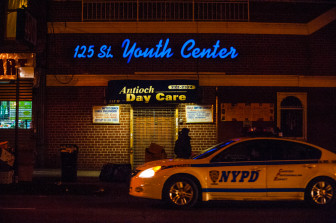
Robert Stolarik / JJIE
A man walks past the 125th Street Youth Center in Harlem on a recent evening.
Dedications to the dead like those to Chicken are familiar in the Grant Houses, as they are less than a mile away and just across Broadway at the Manhattanville Houses. The two apartment complexes sit on superblocks on the northwest corner of Harlem, just a few blocks from Columbia University, which is in the process of building a new science center right in between the houses.
Like much of gentrified New York, the neighborhood has recently transformed in ways that are hard to believe. But even as newer and richer residents have moved in, the prospects for the teenagers in the houses have remained stagnant at best. Occasionally a side street shuts down and some do-gooders roll out a lopsided basketball hoop on wheels, or a scuffed ping pong table or some other ramshackle distraction. But most of the time, it’s a life of monotony. School and the streets, streets and school. No community center, no programs.
“Myself, and Arnita and Taylonn, we’re adamant about this,” Haynes said. “We have a big issue here. Kids are going to die. We negotiated a truce, we got these kids to put their guns down for a while, and check their bad attitudes and be neutral. But there’s only so much we could do.”

Robert Stolarik / JJIE
Police patrol outside 3170 Broadway at the Grant Houses where Tayshana Murphy was shot and killed.
The violence can break out anywhere. Haynes and Murphy recalled an incident at the pool over the summer. Some Manhattanville youths saw some Grant youths in the public pool and the two groups collided at the fence and threatened each other through the fence. The violence grew so bad at the juvenile detention facilities that the arrestees from the two houses needed to be sent to different boroughs to keep them from fighting while in custody.
The most recent incident reported to police in this boredom-fueled blood feud occurred a few weeks ago. Some teenagers from the Grant Houses attacked a 17-year-old boy from Manhattanville near a store on Old Broadway.The victim was beaten with an unknown object and suffered cuts to his head and chest. Javon Peterson, 16, and Terrance Milton, 21, were arrested and charged with second degree gang assault, according to police.
A trip to the Lincoln Fried Chicken near Old Broadway, a contested neutral zone where much of the violence occurs, can lead to a brick attack, or a beat down. Often, the victims of these non-life threatening attacks don’t even bother reporting these incidents to police. They bring them back to their people at the houses.
Haynes and Murphy said the local children are indoctrinated into the feud at younger and younger ages. They said boys as young as 11 and 12 are recruited by the older teenagers to start scrums with the children from the other complex. They’ll have them collect rocks, bottles, and any projectiles they can find on the street or rummage from a city garbage can, and go and throw them at their rivals. These lead to fights that lead to beatings that lead to retaliation until the violence ends at the end of the barrel of a gun. And then the cycle of vengeance starts up again.
A Killer’s Mother, A Victim’s Father and a Desperate Plea
It all started with a dance.
Eli Haynes Jr., a 15-year-old, had attended a party one summer night in 1972. He would not make it home to his apartment in the Manhattanville Houses. A trifling dispute over a girl and a dance that lasted too long led to a gun brandished by one of the boys. Eli ran to break it up and was shot. He bled to death on the basketball court. Haynes was 10 when his brother was gunned down. He remembers the frantic moments when the news reached his house, even now as he tries to end the violence that some residents say started this rivalry.
“This right here, we’re two minutes from Ground Zero, so put your helmets on,” Haynes says with a smile.
On the route from Grant to Manhattanville he gives a running commentary of the rivalry.
“A boy was stomped there,” he said pointing to a stretch of wide sidewalk. “Over there one was attacked with bottles. They’ll move from their fists to bottles, from bottles to bats, from bats to knives, and from knives to the gun.”
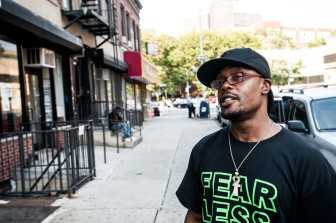
Robert Stolarik / JJIE
Mighty Mike Cee speaks about the feud in the neighborhood.
On the way he runs into an old friend. The Mighty Mike Cee started his rap group in 1972, the same year the feud caught its first body, Haynes’s bother Eli. The band was named the Fearless Four, and it featured two members from Grant and two from Manhattanville. Back then it was no big deal. Now the Mighty Mike Cee, a father of two daughters in Manhattanville, said such a thing would be unimaginable.
“These same kids who are firing at each other and whatnot are the same kids who are going to school with each other,” he said. “It’s about the kids. Ever since that night Chicken got killed there’s been major beef. These kids hope to harm each other.”
Haynes continues his routine patrol, walking back and forth between the Grant and Manhattanville houses when a young man catches his eye. Earlier in the year, Haynes met this boy after he had been arrested and brought into the Bronx juvenile correctional facility where Haynes works. The boy, 16 and a resident of the Grant Houses, recognized Haynes as a prominent resident from Manhattanville. The boy made Haynes a promise that night. He told Haynes that as soon as he got out he’d take care of him on the street.
Now, months later, he is walking along Broadway with a friend near 126th Street. This is the first time they have seen each other since the boy made the threat. Haynes pulls him aside.
“Hey,” he calls out. “You remember me,” he asks with a knowing smile.
A look of recognition flashes on the boy’s face. Haynes approaches him.
“How you doing?”
“Nothing,” the boy responds sullenly.
“What are you doing?”
“You know, chilling,” he responds.
They exchange a few words. Haynes asks if he needs anything. The boy shakes his head sheepishly.
“A job,” he answers without hesitation.
“We’re working on it,” Haynes said, clasping the young man’s hand and pulling him affectionately into his chest . “We’re working on it.”
Both Sides of the Gun
Haynes and Murphy envision turning Old Broadway, the ground zero of all the violence, into a demilitarized zone -- a permanent “play street.” They want to convert two abandoned, shuttered beauty salons into youth community centers, staffed with mediators, intervenors with moral authority, seen by youths from both sides as credible.
“We all are coming together to try to get this thing squashed,” Haynes said. “It’s rare to have parents from both sides of the gun to come together and and bring a message of peace to the community.”
The young people tell Brockington and Haynes and Murphy that they respect what the three survivors are doing. But they add, they need more than three symbols; they need something to do.
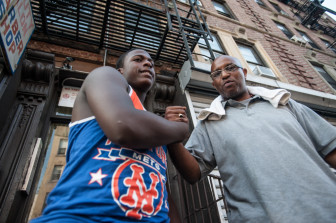
Robert Stolarik / JJIE
Taylonn Murphy, father of the slain Tayshana Murphy, with Naquan Brockington, the brother of Tayshana's killer. The two have been trying to show solidarity in the hope it will end the violence in the community.
“These programs do more than just get them off the street,” Murphy said. “It does more than give them opportunity to get employment. It gives them something else they need -- to show them that someone out there cares,” he said as he walked through the courtyard of the Grant Houses, nodding and making himself visible to anyone who might need his counsel.
While Arnita and Taylonn have been able to set aside their differences, their children have not. Naquan Brockington, Arnita’s son and Tyshawn’s younger brother, and Bam Bam Murphy, Chicken’s younger brother, still resent each other.
“I don’t think there’s a lot of people who are willing to do it, I caught a lot of heat for it, from my mother and my children, but they’re coming around slowly but surely.” “Once we start thinking this is a normal way of life then we’re basically committing to genocide.”
A Passport For Success
It was cramped and hot in the Community Board building. Members from both houses, some of whom had fought in the past, sat scrunched together around a small office table. Outside, Old Broadway had been converted for the day into a “Play Street” with a basketball hoop rolled out for the local youth to shoot around.
A mix of community affairs officers and patrol cops from the 26th Precinct lingered at the end of the street. Inside, Theodore Gershon, an adviser in his 60s from Columbia University’s community affairs office, led a jobs seminar organized by Murphy and Haynes. They described it as a “baby step,” a way to get the two sides to sit down and focus on something other than revenge. Gershon would later comment on how he had never felt so much tension in a room before.

Robert Stolarik / JJIE
A play street along Old Broadway set up by the community board and local police station.
Gershon explained to the teenagers and young adults in attendance, among them Tayshana’s brother, that this was a long step in the often frustrating process of just being able to get a chance to get an opportunity to get in a line for a job. He handed out some forms and leaflets. One of them read: “My Passport For Success” and had bullet points of advice on how to secure and keep a job: “Attitude and Behavior, Initiate and Seek Opportunities, Adapt to change.”
As Gershon walked everyone through what to fill out and where to send it, Bam Bam, 17, noticed through the window that Tyshawn Brockington kept riding and popping wheelies on his bike to get his rivals attention and glowering at him. Bam Bam’s friend elbowed him and motioned with a meaningful expression to Brockington’s display. Their eyes met through the window. Bam Bam exploded.
“This is bullshit man,” he barked. “We need jobs now. Not these forms,” he said slamming his fists on the table.
He got up and headed for the door with his friend in tow. Taylonn hustled after him. Father and son, exchanged heated words. Bam Bam tensed up. Across the street, Brockington kept staring. The young residents from both sides were waiting for something to happen. Police noticed the tension and got ready to move.
Taylonn calmed his son down enough to send him in the direction of the Grant Houses and away from Brockington. He stalked off agitated, but he left without incident.
Afterward, Taylonn was in good spirits.
“That was the first time they’ve been together since Chicken was killed where they have gotten into a physical confrontation,” he said beaming.
We Ain’t No Gang
After Bam Bam left, Arnita led her son over to Gershon. The two had a long conversation, and Brockington took his card with a promise to call him soon.
Bam Bam has a disarming, wide smile and a tattoo that runs the length of his arm that reads “Loyalty Over Love.” It took awhile, he said, for him to come to terms with his father’s mission to embrace the mother of the rival who murdered his sister. And there are times when it’s harder to accept than others.
“At the end of the day we took a loss, we lost my sister, and people have a certain feeling over that,” he said.
He said he is frustrated that outsiders see him and his friends as irredeemable thugs. He says he is just as frustrated by the violence.

Robert Stolarik / JJIE
A sign on the elevated subway line on 125th Street asking for help in a recent attack.
“We’re out here strong,” he said. “They labeled us a gang. We ain’t no gang. We just grew up together. We don’t have secret meetings or talk about stuff like that.”
Bam Bam made a motion with his fingers indicating money.
“Listen, man, if we had some money, if we had jobs,” he made a sweeping gesture with his arms taking in both projects. “This whole thing, this beef? There’d be no beef. No one would care.”
Naquan Brockington, although he would never admit in front of Bam Bam, agrees.
“I don’t know why we’re fighting,” he said after a long pause. “We don’t know what we’re fighting for really. Hopefully before someone dies again this thing will be squashed. Nobody knows. Maybe if we had some jobs out here, something to do, we wouldn’t be fighting.”
Brockington said his brother gave him a message to deliver to his people in Manhattanville.
“He tells them all to stop fighting. He gave the call to stop fighting. He don’t want them to be where he’s at. He looks at it, like, that his life is already gone, it’s over. He doesn’t want me or his friends in the situation he in -- behind bars facing 25 to life.”
He talks about his brother obliquely, without explicitly mentioning the killing.
“It’s stressful,” he said about his brother in jail, possibly for the rest of his life. “I’m sad. I’m missing him. I hate that he put himself in that predicament. He don’t really talk about it. When I see him he says he just wants to come home.
“They be trying to stop it, but there’s nothing they can do. They can’t stop it. The only way it’s going to stop is if we stop it. Some of them is listening, but I can’t stop tell them what to do, they’re the same age as me.”
“I want to go to a safe place”
The last thing Venus Singleton remembers hearing as she sat on a bench outside of her building on 550 125th St. in the Grant Houses before the gun shots was her son LaQuint’s voice. He was warning her and his little brother to get inside.
“He went to the little chicken place around the corner,” she said recalling the evening. “He yelled, ‘Mom! You and Karron get back in the building!’ I wasn’t confused. I saw like nine of them together. I yelled at my little son to get back in the building and that’s when it happened.”
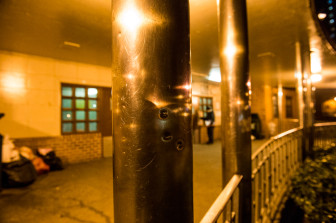
Robert Stolarik / JJIE
Bullet holes on a pillar outside the Grant Housing Project where a recent shooting between the rival buildings took place.
She heard five shots. The dents from the bullets are visible on a column above her head where she stands and recounts what happened that evening. Everybody was running up the path toward the building in a frenzy, but not LaQuint. She pushed past the frenzied crowd and headed toward the sound of the gunfire.
“Everybody was running one way and I was going the other,” she said. “Where the hell was LaQuint at? That’s all I was thinking. I needed to see where my son was at.”
When she saw him, at the spot where the pathway meets the sidewalk, lying in a burgeoning pool of his own blood, she thought he was dead.
And then he lifted his head.
“‘Mom calm down,’ he told me,” she said. “‘It don’t hurt that much. I’m money,’ he told me.”
Singleton saw the gunman and his accomplices running across the street toward Old Broadway and the Manhattanville Houses. Someone nearby flagged down a patrol car and paramedics were called. While he was lifted into the back of the ambulance, LaQuint confided to his mother: “I can’t cry, mom. I can’t cry. I can’t cry.”
“It was a lot of pride,” she said. “He wouldn’t drop a tear.”
Singleton said she does not know what the answers are. She said the inexplicable feelings these children have toward each other show no signs of letting up. She wants someone to do something, but isn’t certain what that is.
“In the last few years there have been more shootings, more gunshots, it ain’t getting better, it’s just getting worse,” she said. “A lot of mothers are going to cry if we don’t do something about this. It’s a life or death situation for my sons and I want to go to a safe place but I don’t know where that is.”
A lot changed for Singleton after the shooting. The light went out in LaQuint’s eyes, she said. He used to be full of energy. Now, she said, he just sits and stares. She had to learn how to change a colostomy bag. She consults a sheet obsessively to make sure she is properly following the instructions.
She has learned that the type of bowel movements her son has and the type of bag he uses affects how long to keep the pouch on. He doesn’t have the disposable bags. So she needs to be attentive to wash them out thoroughly. She made an anguished sound trying to explain the sense of shame she felt being disgusted having to handle her son’s excrement.
At first, the process would make her dry heave, but she has started to get used to it. She still calls the nurses several times a day to make sure she doesn’t make a mistake. She worries if she does, that he’ll get an infection. Then, she’ll make things worse than they already are.
